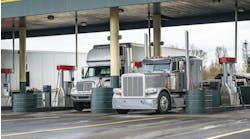You can actually have too much of a good thing when it comes to data. Commercial trucking fleets now run on more data than ever, from fuel efficiency stats to real-time driver behavior and predictive maintenance alerts.
In theory, all of this data should supercharge operations. The problem is that too much data, poorly managed, can have the exact opposite effect of what was intended, leading to inefficiency instead of helping fleets run smoothly and more efficiently.
In a connected fleet, telematics systems stream continuous data from every vehicle, from engine health to driver habits, and all in real time. But all of this data can overwhelm fleet managers; they can spend more time interpreting dashboards than making informed decisions. When overwhelmed by data points, decision-makers struggle to prioritize or act, resulting in inefficiencies.
It’s vital that systems do more than just provide raw data; they need to provide actionable intelligence. Metrics are meaningless unless tied to actionable insights.
Data silos create their own problems
In an ideal world, every piece of data across the fleet would integrate into one unified system. But fleets often rely on a number of disconnected platforms: one for telematics, another for fuel management, and a third for maintenance scheduling.
When these systems don’t communicate, data becomes siloed, preventing managers from getting a complete picture. That results in forcing managers to piece together fragmented insights. And that’s a huge inefficiency. Instead of optimizing routes or addressing vehicle downtime, managers end up wasting time going back and forth between systems and trying to translate information.
Worse, when data is siloed, fleet managers miss critical information. A maintenance issue might be tied to poor fuel efficiency, or driver behavior could signal a safety risk that affects delivery times. If these insights remain trapped in different systems, managers can miss this vital information, which then never gets dealt with and resolved.
AI is changing the game
The future of trucking won’t be about having the most data. It will be about having the right data, delivered at the right time. Fleet operators need smarter systems that prioritize key insights over raw data dumps.
Emerging AI and machine learning platforms are starting to address this issue, filtering out the noise and highlighting actionable insights. These systems don’t just collect data; they analyze it in real time and offer recommendations that matter. Whether it’s predicting a part failure before it happens or suggesting optimal routes based on real-time traffic, intelligent data helps fleets run leaner and faster.
But even as AI evolves, final decision-making is still up to the fleet managers, and that means they need to trust their data while also trusting their instincts to deliver just enough information to support decision-making without overwhelming the user.
See also: Driver and fuel data reveal the best freight corridors nationwide
Managing the flow
So how do fleets avoid drowning in data? It’s all about control. Data needs to be filtered, refined, and integrated into a system that works across departments. Instead of overwhelming managers with raw information, fleet systems should focus on curating actionable insights.
Rather than relying on disparate systems and platforms, fleets should consolidate platforms so that maintenance, fuel management, and telematics all speak the same language. It means setting priorities on which metrics matter most, rather than trying to track every movement of every truck.
Remember, no matter how much data a fleet collects, it’s only valuable if someone can make sense of it.
The data dilemma
The industry is at a tipping point. Data is only a powerful tool when it’s used correctly. Too much data, poorly managed, becomes a liability rather than an asset.
To avoid inefficiencies, fleets need to focus on quality over quantity and trust in systems that prioritize insight over information overload. In the end, it’s not about having the most data; it’s about having the right data that will help your fleet managers succeed.



